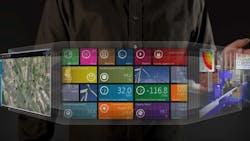Will SCADA Remain Relevant as Industry Advances?
The rise of concepts like the Industrial Internet of Things (IIoT) and more formalized digitalization movements like Industry 4.0 have led many in industry to wonder about the future of automation hardware and software. Clearly, technologies like sensors and controllers and industrial networks won't disappear, as they provide the key sources of data and data conveyance required by IIoT. But what about automation technologies like SCADA? How will such technologies adapt—or be replaced—as industry becomes more connected?
Such questions are not just vague musings on the future relevance of current technologies. They also address the kinds of decisions industrial companies must make today to guide their near-term automation investment decisions.
“The frank reality is that SCADA as an operator interface and the features that make it obligatory—such as schematic visualisation, alarming, data logging, real-time control and the passing of data to data historians—are not going to be completely negated by IIoT technology. At least not anytime soon,” says Sam Walton of Iconics UK, a supplier of HMI/SCADA, analytics and energy management software. He contends that it’s not a question of whether or not SCADA will be replaced by IIoT technologies. The more appropriate question to ask, Walton suggests, is: “Can the two concepts be integrated and what role will they play in the factory of the future as a new tidal wave of data from the IIoT surfaces?”
To underscore his point, Walton says, “One cannot compare IIoT solely with data acquisition (DA), yet forget about supervisory control (SC) and the need for reliability, security, fast aggregation and complex data storage.” He even references IIoT communication protocols, such as AMQP and JSON, that support the SC and DA elements via the IIoT. “These protocols help fulfill the role of a macro-level control and analytical toolset that can unite IT and OT (operations technology). Therefore, supervisory control and security are not sacrificed, but embellished within existing infrastructure” with the aid of these communication platforms, he says.
In fact, Walton believes that “the heterogeneous nature of the factory of the future paves the way for these additional IIoT communication platforms, like AMQP and JSON, that can truly unite and manage the disparate nature of the industrial digital ecosystem. After all, interoperability, information transparency and decentralized decisions are three of the four design principles that underpin Industry 4.0.”
Walton points out that, in many cases, SCADA/visualization technologies have long been moving down this path. “With the rate at which connected devices are gathering, exchanging and analyzing data, the need for interoperability and information transparency has grown,” he says. “Certain progressive—and hardware agnostic—technology suppliers have always embraced this need and now natively support key IIoT protocols.”
Speaking for Iconics UK, Walton says these trends have been playing out at the company for a number of years around such approaches as:
* The unification of disparate SCADA systems, along with their various versions and protocols;
* The collection of exposed data via web services and IoT communication protocols while controlling process securely in real-time;
* Bi-directionally controlling a variety of cost-effective IoT devices via a secure IoT gateway;
* Delivering software updates remotely;
* Tapping into unconnected or ignored energy data sitting in the field or database;
* Applying complex business logic and predictive maintenance algorithms to operational data and assets without investing in expensive analytical alternatives that require huge data lakes;
* Filtering inconsequential and subordinate alarms across multiple alarm servers, devices and systems; and
* Running post-filtered data, from analytics at the edge, into cloud-based control systems.
Considering the forward-looking direction Iconics and other SCADA/visualization technology suppliers have been headed in by exploring and developing capabilities such as those cited above, Walton says it’s clear that the IIoT will not eliminate SCADA, but that the two will be tightly integrated.
“Despite traditional SCADA systems operating in the ‘micro’ environment of manufacturing, collecting and visualizing the day-to-day operations of a factory or process as the ‘macro’ environment of Industry 4.0 and IIoT expands, a more powerful SCADA is already here” for use in this expanding macro environment, says Walton.
With SCADA suppliers positively reacting to industry’s interest in IIoT and Industry 4.0, Walton says the main question for end users need not be focused on the relevance of SCADA to IIoT, but on the core questions industry has historically asked, i.e. how can we use these technologies to meet customer needs more quickly, cheaply and with better quality?
About the Author
David Greenfield, editor in chief
Editor in Chief

Leaders relevant to this article:
